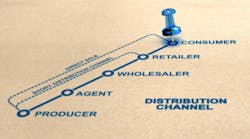The wins and worries for manufacturers going direct-to-consumers
Dusty Dean describes his Oregon-based company BITCADET as “a one-stop source for manufacturers who are serious about building a digital sales strategy and growing beyond their dreams.”
Heady stuff.
His team of technologists, digital sales reps and industry analysts function as his clients’ outsourced digital-growth department, relying on the direct-to-consumer (DTC) model to quicken processes.
It’s an interesting approach—more direct than most. We wanted to learn more, so we posed a few questions to the founder. Take a look…
Smart Industry: Describe BITCADET and your role there.
Dusty: I’m the CEO of BITCADET. We’re a technology and consulting company that creates fast-growing digital sales channels for manufacturers. We do all the work so our clients can focus on what they do best—building and shipping quality products.
Smart Industry: What is the DTC model and how is it changing in the digitalization era?
Dusty: Customers increasingly want to research and buy their goods directly from the maker of the product. The manufacturer is seen as the expert. This is bypassing traditional sales channels such as dealers, distributors and retailers. On top of this, supply chain issues, raw material price hikes, and draconian price controls have made the traditional retail experience for manufacturers less profitable. The barrier to entry for selling e-commerce no longer exists; it is now both economically accessible and easy for even the smallest manufacturers to create their own online store and sell direct.
Smart Industry: What affect does this have on the manufacturing of goods? Any difference with process vs. discrete?
Dusty: The largest change is in fulfillment and customer experience. By selling direct to their customers, manufacturers will likely be filling more individual, potentially small-batch orders more quickly. From a customer-experience perspective, there will be more support queries about these orders and troubleshooting will need to be done expediently for anything that goes awry. The good news is that manufacturers get paid faster for these orders, respond faster to any customer concerns, and leverage customer feedback to improve the sales experience quickly and markedly.
Smart Industry: What new tools / techniques can optimize the DTC approach?
Dusty: One of the greatest benefits is getting access to first-party customer data (from email addresses, phone numbers, and other useful customer info) that customers share. This data is becoming increasingly more valuable because of evolving privacy and data-sharing legislation. The use of machine learning and predictive behavioral algorithms allow the company to send more relevant content and offers to customers. The power is in this one-to-one relationship and how companies use it to empower customers to buy from them.
Smart Industry: How is the pandemic changing the world of DTC?
Dusty: Two big disruptions created by the pandemic were (1) spikes in raw material pricing and (2) inventory instability because of labor and freight issues. Many manufacturers who sold through retailers found their traditional tactics of being resistant to or slow walking pricing; inventory changes were incredibly disruptive to their profitability. As a result, companies such as Goodyear and Mattel found that selling through their own channels could be more lucrative because they could change their own pricing and inventories instantaneously and protect their profit margins. Customers are adapting to inflation and delayed delivery expectations. These changes have not hurt manufacturers.
Smart Industry: What backend ramifications does this have?
Dusty: From a backend technical point-of-view, the fact that inventory has been unreliable has affected the sales processes. With shortages in inventory, companies must have the software in place to quickly adapt to show stock-outs so that they are not selling products they do not have. From a people and processes point of view, if companies are not selling DTC, they will need to make sure they have strong fulfillment processes and good customer experience representatives in place. This works all the way from raw-materials fulfillment to shipping-delivery partners because the goal is to get every order to each customer as promised to increase customer lifetime value.
Smart Industry: Do customers want this direct access? What are the benefits? What challenges exist?
Dusty: Pre-pandemic research suggests that customers increasingly want to buy directly from the manufacturers because they feel they are getting the best source of information, they know they are not buying a counterfeit product, and they are getting the best customer experience. This has only increased because of the pandemic. Benefits for selling direct include building long-term relationships with customers, controls over pricing, meeting customer expectations including providing any product information, and allowing companies to test out new product and sales ideas.
As far as challenges, companies will likely need to fulfill smaller batch orders, and add a customer-experience team for online fulfillment. Additionally, an increased marketing budget is key to attracting the customers to the store. Lastly, traditional sales partners may feel threatened if a company sells direct.



